A Comprehensive Overview of Child Development: Stages and Theories
VerifiedAdded on 2023/06/14
|12
|3681
|229
Report
AI Summary
This report provides a comprehensive overview of child development from birth to adulthood, emphasizing the critical stages, influential factors, and key theories that shape a child's growth. It covers cognitive, emotional, physical, social, language, and communication development, highlighting the importance of early childhood experiences and the roles of parents and educators. The report delves into Piaget's transition theory, Vygotsky's social interaction theory, and Bowlby's attachment theory, explaining how these frameworks impact a child's learning and emotional well-being. It also addresses the significance of managing transitions in a child's life, such as starting daycare or experiencing family changes, and underscores the need for a stable and positive environment to foster healthy development. The report further discusses the impact of health, poverty, learning abilities, and family environment on a child's overall development, advocating for inclusive teaching practices that cater to individual needs and promote equal opportunities for all children. Desklib offers a wealth of resources for students seeking to further explore these topics.

Child Development
Paraphrase This Document
Need a fresh take? Get an instant paraphrase of this document with our AI Paraphraser
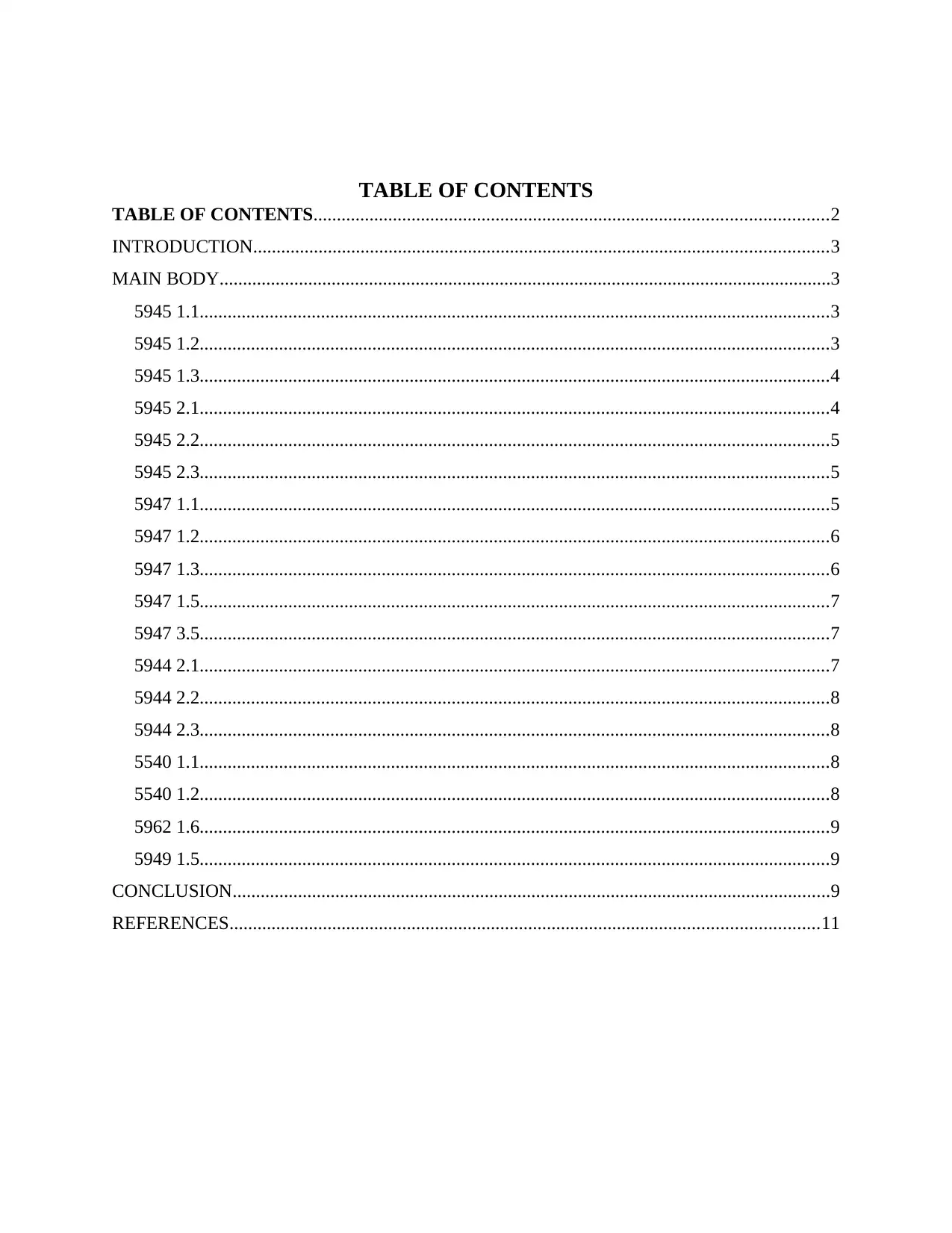
TABLE OF CONTENTS
TABLE OF CONTENTS..............................................................................................................2
INTRODUCTION...........................................................................................................................3
MAIN BODY...................................................................................................................................3
5945 1.1.......................................................................................................................................3
5945 1.2.......................................................................................................................................3
5945 1.3.......................................................................................................................................4
5945 2.1.......................................................................................................................................4
5945 2.2.......................................................................................................................................5
5945 2.3.......................................................................................................................................5
5947 1.1.......................................................................................................................................5
5947 1.2.......................................................................................................................................6
5947 1.3.......................................................................................................................................6
5947 1.5.......................................................................................................................................7
5947 3.5.......................................................................................................................................7
5944 2.1.......................................................................................................................................7
5944 2.2.......................................................................................................................................8
5944 2.3.......................................................................................................................................8
5540 1.1.......................................................................................................................................8
5540 1.2.......................................................................................................................................8
5962 1.6.......................................................................................................................................9
5949 1.5.......................................................................................................................................9
CONCLUSION................................................................................................................................9
REFERENCES..............................................................................................................................11
TABLE OF CONTENTS..............................................................................................................2
INTRODUCTION...........................................................................................................................3
MAIN BODY...................................................................................................................................3
5945 1.1.......................................................................................................................................3
5945 1.2.......................................................................................................................................3
5945 1.3.......................................................................................................................................4
5945 2.1.......................................................................................................................................4
5945 2.2.......................................................................................................................................5
5945 2.3.......................................................................................................................................5
5947 1.1.......................................................................................................................................5
5947 1.2.......................................................................................................................................6
5947 1.3.......................................................................................................................................6
5947 1.5.......................................................................................................................................7
5947 3.5.......................................................................................................................................7
5944 2.1.......................................................................................................................................7
5944 2.2.......................................................................................................................................8
5944 2.3.......................................................................................................................................8
5540 1.1.......................................................................................................................................8
5540 1.2.......................................................................................................................................8
5962 1.6.......................................................................................................................................9
5949 1.5.......................................................................................................................................9
CONCLUSION................................................................................................................................9
REFERENCES..............................................................................................................................11
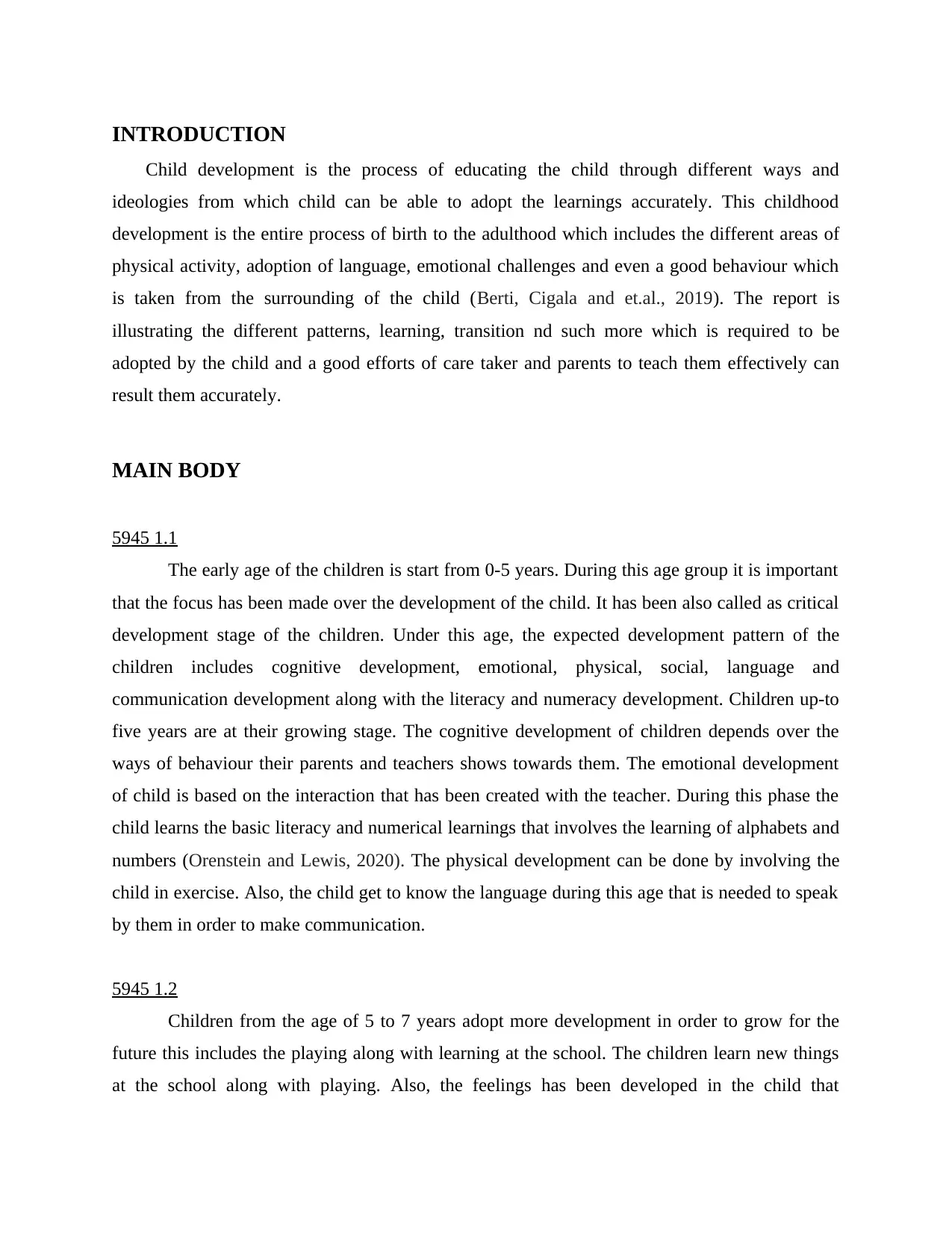
INTRODUCTION
Child development is the process of educating the child through different ways and
ideologies from which child can be able to adopt the learnings accurately. This childhood
development is the entire process of birth to the adulthood which includes the different areas of
physical activity, adoption of language, emotional challenges and even a good behaviour which
is taken from the surrounding of the child (Berti, Cigala and et.al., 2019). The report is
illustrating the different patterns, learning, transition nd such more which is required to be
adopted by the child and a good efforts of care taker and parents to teach them effectively can
result them accurately.
MAIN BODY
5945 1.1
The early age of the children is start from 0-5 years. During this age group it is important
that the focus has been made over the development of the child. It has been also called as critical
development stage of the children. Under this age, the expected development pattern of the
children includes cognitive development, emotional, physical, social, language and
communication development along with the literacy and numeracy development. Children up-to
five years are at their growing stage. The cognitive development of children depends over the
ways of behaviour their parents and teachers shows towards them. The emotional development
of child is based on the interaction that has been created with the teacher. During this phase the
child learns the basic literacy and numerical learnings that involves the learning of alphabets and
numbers (Orenstein and Lewis, 2020). The physical development can be done by involving the
child in exercise. Also, the child get to know the language during this age that is needed to speak
by them in order to make communication.
5945 1.2
Children from the age of 5 to 7 years adopt more development in order to grow for the
future this includes the playing along with learning at the school. The children learn new things
at the school along with playing. Also, the feelings has been developed in the child that
Child development is the process of educating the child through different ways and
ideologies from which child can be able to adopt the learnings accurately. This childhood
development is the entire process of birth to the adulthood which includes the different areas of
physical activity, adoption of language, emotional challenges and even a good behaviour which
is taken from the surrounding of the child (Berti, Cigala and et.al., 2019). The report is
illustrating the different patterns, learning, transition nd such more which is required to be
adopted by the child and a good efforts of care taker and parents to teach them effectively can
result them accurately.
MAIN BODY
5945 1.1
The early age of the children is start from 0-5 years. During this age group it is important
that the focus has been made over the development of the child. It has been also called as critical
development stage of the children. Under this age, the expected development pattern of the
children includes cognitive development, emotional, physical, social, language and
communication development along with the literacy and numeracy development. Children up-to
five years are at their growing stage. The cognitive development of children depends over the
ways of behaviour their parents and teachers shows towards them. The emotional development
of child is based on the interaction that has been created with the teacher. During this phase the
child learns the basic literacy and numerical learnings that involves the learning of alphabets and
numbers (Orenstein and Lewis, 2020). The physical development can be done by involving the
child in exercise. Also, the child get to know the language during this age that is needed to speak
by them in order to make communication.
5945 1.2
Children from the age of 5 to 7 years adopt more development in order to grow for the
future this includes the playing along with learning at the school. The children learn new things
at the school along with playing. Also, the feelings has been developed in the child that
⊘ This is a preview!⊘
Do you want full access?
Subscribe today to unlock all pages.

Trusted by 1+ million students worldwide
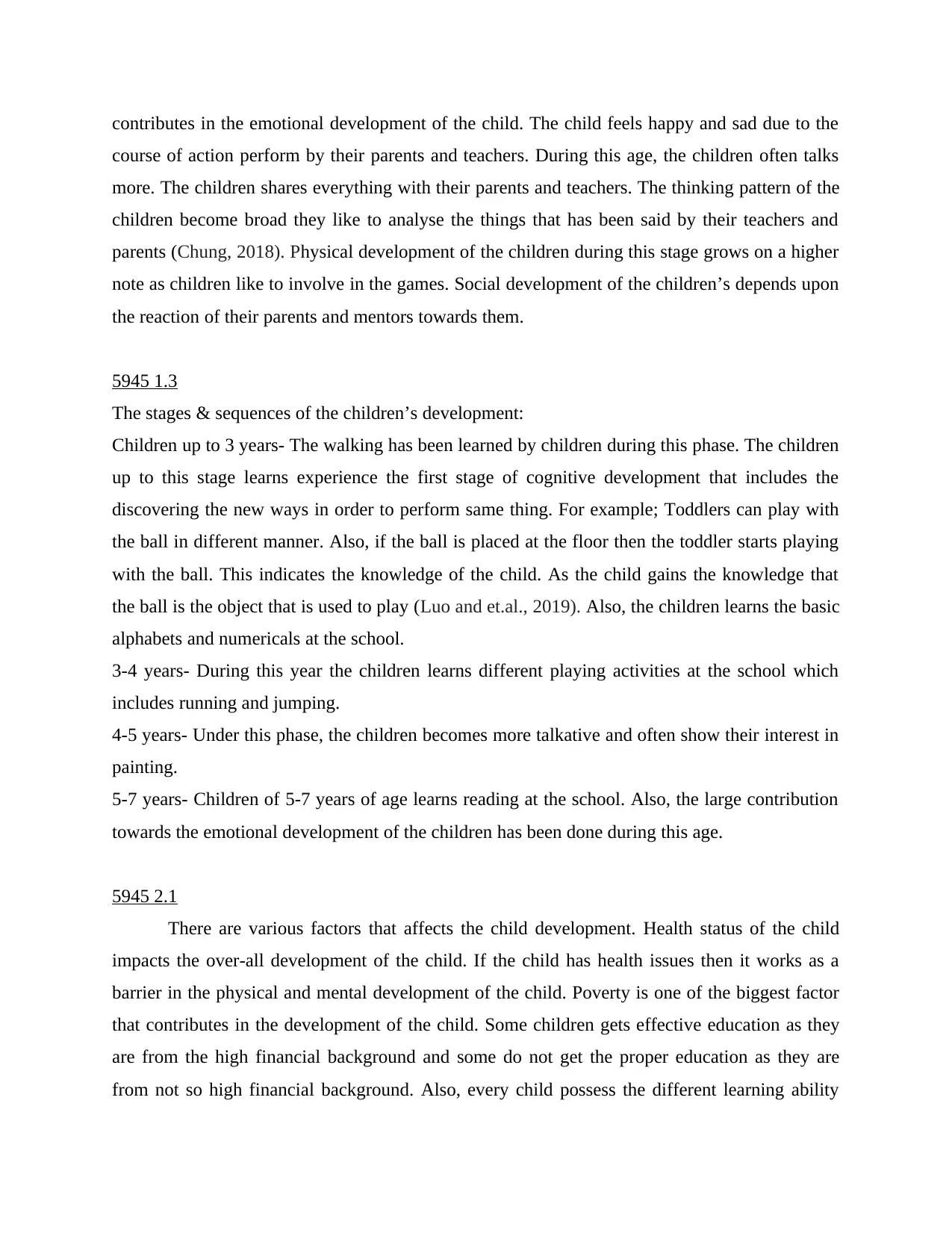
contributes in the emotional development of the child. The child feels happy and sad due to the
course of action perform by their parents and teachers. During this age, the children often talks
more. The children shares everything with their parents and teachers. The thinking pattern of the
children become broad they like to analyse the things that has been said by their teachers and
parents (Chung, 2018). Physical development of the children during this stage grows on a higher
note as children like to involve in the games. Social development of the children’s depends upon
the reaction of their parents and mentors towards them.
5945 1.3
The stages & sequences of the children’s development:
Children up to 3 years- The walking has been learned by children during this phase. The children
up to this stage learns experience the first stage of cognitive development that includes the
discovering the new ways in order to perform same thing. For example; Toddlers can play with
the ball in different manner. Also, if the ball is placed at the floor then the toddler starts playing
with the ball. This indicates the knowledge of the child. As the child gains the knowledge that
the ball is the object that is used to play (Luo and et.al., 2019). Also, the children learns the basic
alphabets and numericals at the school.
3-4 years- During this year the children learns different playing activities at the school which
includes running and jumping.
4-5 years- Under this phase, the children becomes more talkative and often show their interest in
painting.
5-7 years- Children of 5-7 years of age learns reading at the school. Also, the large contribution
towards the emotional development of the children has been done during this age.
5945 2.1
There are various factors that affects the child development. Health status of the child
impacts the over-all development of the child. If the child has health issues then it works as a
barrier in the physical and mental development of the child. Poverty is one of the biggest factor
that contributes in the development of the child. Some children gets effective education as they
are from the high financial background and some do not get the proper education as they are
from not so high financial background. Also, every child possess the different learning ability
course of action perform by their parents and teachers. During this age, the children often talks
more. The children shares everything with their parents and teachers. The thinking pattern of the
children become broad they like to analyse the things that has been said by their teachers and
parents (Chung, 2018). Physical development of the children during this stage grows on a higher
note as children like to involve in the games. Social development of the children’s depends upon
the reaction of their parents and mentors towards them.
5945 1.3
The stages & sequences of the children’s development:
Children up to 3 years- The walking has been learned by children during this phase. The children
up to this stage learns experience the first stage of cognitive development that includes the
discovering the new ways in order to perform same thing. For example; Toddlers can play with
the ball in different manner. Also, if the ball is placed at the floor then the toddler starts playing
with the ball. This indicates the knowledge of the child. As the child gains the knowledge that
the ball is the object that is used to play (Luo and et.al., 2019). Also, the children learns the basic
alphabets and numericals at the school.
3-4 years- During this year the children learns different playing activities at the school which
includes running and jumping.
4-5 years- Under this phase, the children becomes more talkative and often show their interest in
painting.
5-7 years- Children of 5-7 years of age learns reading at the school. Also, the large contribution
towards the emotional development of the children has been done during this age.
5945 2.1
There are various factors that affects the child development. Health status of the child
impacts the over-all development of the child. If the child has health issues then it works as a
barrier in the physical and mental development of the child. Poverty is one of the biggest factor
that contributes in the development of the child. Some children gets effective education as they
are from the high financial background and some do not get the proper education as they are
from not so high financial background. Also, every child possess the different learning ability
Paraphrase This Document
Need a fresh take? Get an instant paraphrase of this document with our AI Paraphraser
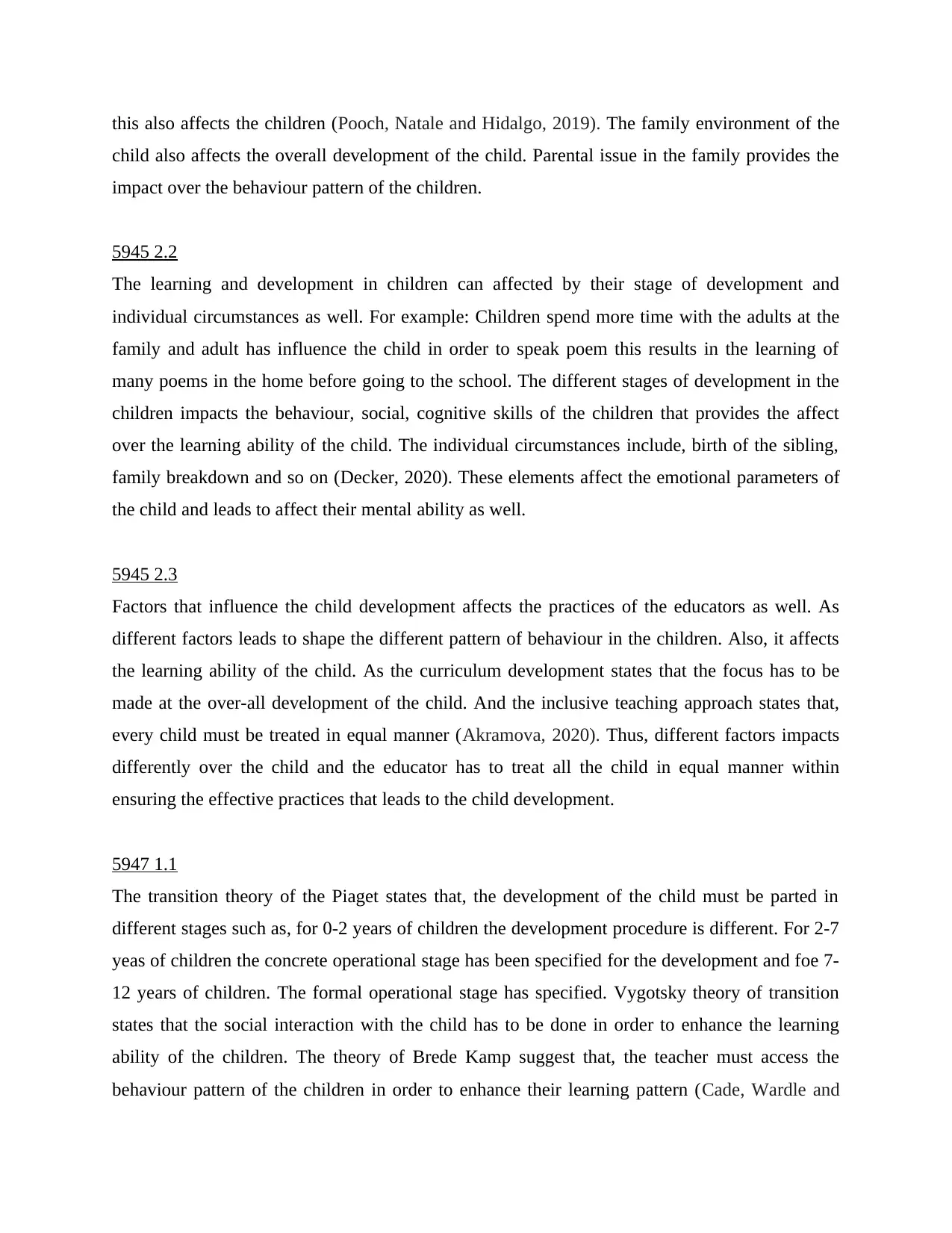
this also affects the children (Pooch, Natale and Hidalgo, 2019). The family environment of the
child also affects the overall development of the child. Parental issue in the family provides the
impact over the behaviour pattern of the children.
5945 2.2
The learning and development in children can affected by their stage of development and
individual circumstances as well. For example: Children spend more time with the adults at the
family and adult has influence the child in order to speak poem this results in the learning of
many poems in the home before going to the school. The different stages of development in the
children impacts the behaviour, social, cognitive skills of the children that provides the affect
over the learning ability of the child. The individual circumstances include, birth of the sibling,
family breakdown and so on (Decker, 2020). These elements affect the emotional parameters of
the child and leads to affect their mental ability as well.
5945 2.3
Factors that influence the child development affects the practices of the educators as well. As
different factors leads to shape the different pattern of behaviour in the children. Also, it affects
the learning ability of the child. As the curriculum development states that the focus has to be
made at the over-all development of the child. And the inclusive teaching approach states that,
every child must be treated in equal manner (Akramova, 2020). Thus, different factors impacts
differently over the child and the educator has to treat all the child in equal manner within
ensuring the effective practices that leads to the child development.
5947 1.1
The transition theory of the Piaget states that, the development of the child must be parted in
different stages such as, for 0-2 years of children the development procedure is different. For 2-7
yeas of children the concrete operational stage has been specified for the development and foe 7-
12 years of children. The formal operational stage has specified. Vygotsky theory of transition
states that the social interaction with the child has to be done in order to enhance the learning
ability of the children. The theory of Brede Kamp suggest that, the teacher must access the
behaviour pattern of the children in order to enhance their learning pattern (Cade, Wardle and
child also affects the overall development of the child. Parental issue in the family provides the
impact over the behaviour pattern of the children.
5945 2.2
The learning and development in children can affected by their stage of development and
individual circumstances as well. For example: Children spend more time with the adults at the
family and adult has influence the child in order to speak poem this results in the learning of
many poems in the home before going to the school. The different stages of development in the
children impacts the behaviour, social, cognitive skills of the children that provides the affect
over the learning ability of the child. The individual circumstances include, birth of the sibling,
family breakdown and so on (Decker, 2020). These elements affect the emotional parameters of
the child and leads to affect their mental ability as well.
5945 2.3
Factors that influence the child development affects the practices of the educators as well. As
different factors leads to shape the different pattern of behaviour in the children. Also, it affects
the learning ability of the child. As the curriculum development states that the focus has to be
made at the over-all development of the child. And the inclusive teaching approach states that,
every child must be treated in equal manner (Akramova, 2020). Thus, different factors impacts
differently over the child and the educator has to treat all the child in equal manner within
ensuring the effective practices that leads to the child development.
5947 1.1
The transition theory of the Piaget states that, the development of the child must be parted in
different stages such as, for 0-2 years of children the development procedure is different. For 2-7
yeas of children the concrete operational stage has been specified for the development and foe 7-
12 years of children. The formal operational stage has specified. Vygotsky theory of transition
states that the social interaction with the child has to be done in order to enhance the learning
ability of the children. The theory of Brede Kamp suggest that, the teacher must access the
behaviour pattern of the children in order to enhance their learning pattern (Cade, Wardle and
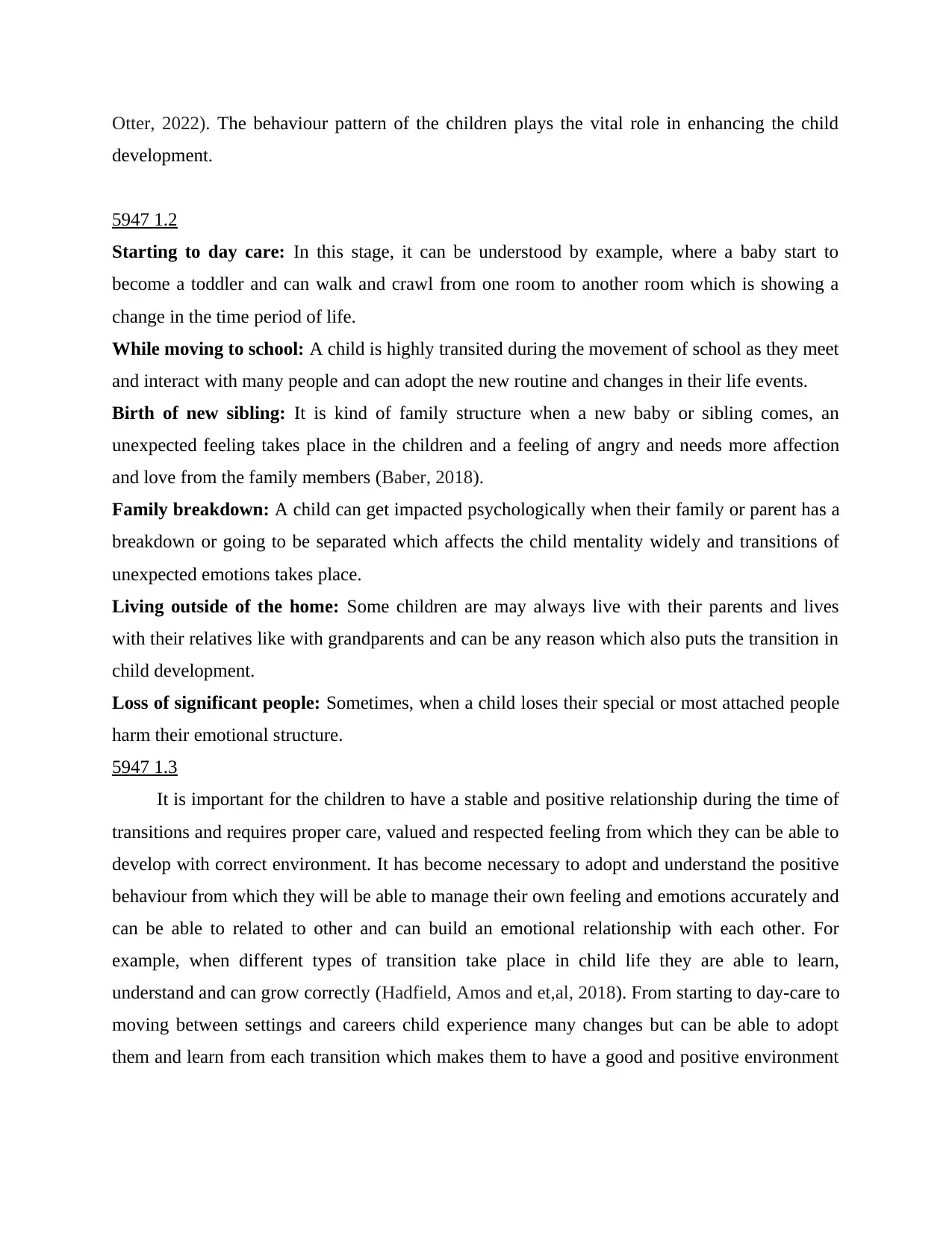
Otter, 2022). The behaviour pattern of the children plays the vital role in enhancing the child
development.
5947 1.2
Starting to day care: In this stage, it can be understood by example, where a baby start to
become a toddler and can walk and crawl from one room to another room which is showing a
change in the time period of life.
While moving to school: A child is highly transited during the movement of school as they meet
and interact with many people and can adopt the new routine and changes in their life events.
Birth of new sibling: It is kind of family structure when a new baby or sibling comes, an
unexpected feeling takes place in the children and a feeling of angry and needs more affection
and love from the family members (Baber, 2018).
Family breakdown: A child can get impacted psychologically when their family or parent has a
breakdown or going to be separated which affects the child mentality widely and transitions of
unexpected emotions takes place.
Living outside of the home: Some children are may always live with their parents and lives
with their relatives like with grandparents and can be any reason which also puts the transition in
child development.
Loss of significant people: Sometimes, when a child loses their special or most attached people
harm their emotional structure.
5947 1.3
It is important for the children to have a stable and positive relationship during the time of
transitions and requires proper care, valued and respected feeling from which they can be able to
develop with correct environment. It has become necessary to adopt and understand the positive
behaviour from which they will be able to manage their own feeling and emotions accurately and
can be able to related to other and can build an emotional relationship with each other. For
example, when different types of transition take place in child life they are able to learn,
understand and can grow correctly (Hadfield, Amos and et,al, 2018). From starting to day-care to
moving between settings and careers child experience many changes but can be able to adopt
them and learn from each transition which makes them to have a good and positive environment
development.
5947 1.2
Starting to day care: In this stage, it can be understood by example, where a baby start to
become a toddler and can walk and crawl from one room to another room which is showing a
change in the time period of life.
While moving to school: A child is highly transited during the movement of school as they meet
and interact with many people and can adopt the new routine and changes in their life events.
Birth of new sibling: It is kind of family structure when a new baby or sibling comes, an
unexpected feeling takes place in the children and a feeling of angry and needs more affection
and love from the family members (Baber, 2018).
Family breakdown: A child can get impacted psychologically when their family or parent has a
breakdown or going to be separated which affects the child mentality widely and transitions of
unexpected emotions takes place.
Living outside of the home: Some children are may always live with their parents and lives
with their relatives like with grandparents and can be any reason which also puts the transition in
child development.
Loss of significant people: Sometimes, when a child loses their special or most attached people
harm their emotional structure.
5947 1.3
It is important for the children to have a stable and positive relationship during the time of
transitions and requires proper care, valued and respected feeling from which they can be able to
develop with correct environment. It has become necessary to adopt and understand the positive
behaviour from which they will be able to manage their own feeling and emotions accurately and
can be able to related to other and can build an emotional relationship with each other. For
example, when different types of transition take place in child life they are able to learn,
understand and can grow correctly (Hadfield, Amos and et,al, 2018). From starting to day-care to
moving between settings and careers child experience many changes but can be able to adopt
them and learn from each transition which makes them to have a good and positive environment
⊘ This is a preview!⊘
Do you want full access?
Subscribe today to unlock all pages.

Trusted by 1+ million students worldwide
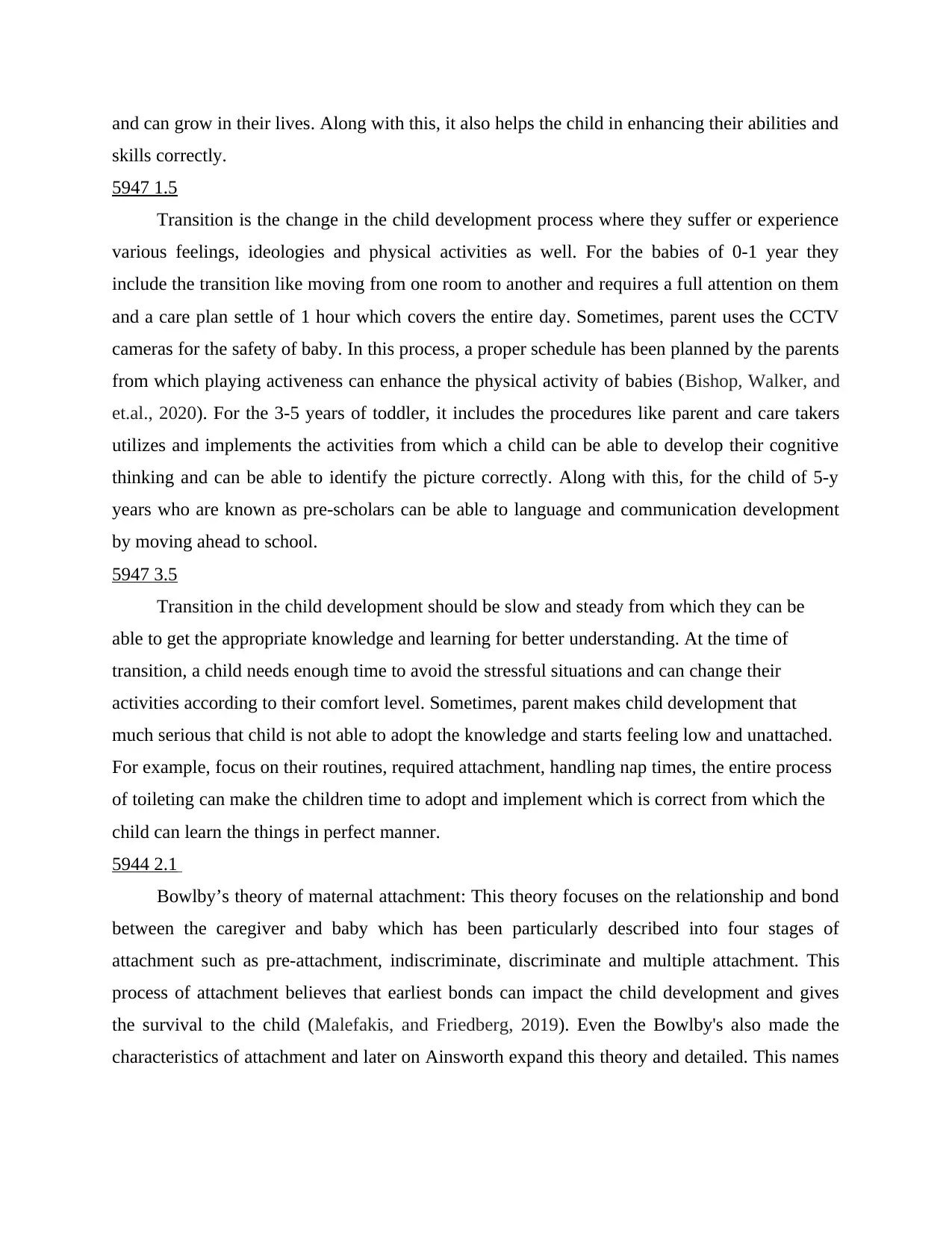
and can grow in their lives. Along with this, it also helps the child in enhancing their abilities and
skills correctly.
5947 1.5
Transition is the change in the child development process where they suffer or experience
various feelings, ideologies and physical activities as well. For the babies of 0-1 year they
include the transition like moving from one room to another and requires a full attention on them
and a care plan settle of 1 hour which covers the entire day. Sometimes, parent uses the CCTV
cameras for the safety of baby. In this process, a proper schedule has been planned by the parents
from which playing activeness can enhance the physical activity of babies (Bishop, Walker, and
et.al., 2020). For the 3-5 years of toddler, it includes the procedures like parent and care takers
utilizes and implements the activities from which a child can be able to develop their cognitive
thinking and can be able to identify the picture correctly. Along with this, for the child of 5-y
years who are known as pre-scholars can be able to language and communication development
by moving ahead to school.
5947 3.5
Transition in the child development should be slow and steady from which they can be
able to get the appropriate knowledge and learning for better understanding. At the time of
transition, a child needs enough time to avoid the stressful situations and can change their
activities according to their comfort level. Sometimes, parent makes child development that
much serious that child is not able to adopt the knowledge and starts feeling low and unattached.
For example, focus on their routines, required attachment, handling nap times, the entire process
of toileting can make the children time to adopt and implement which is correct from which the
child can learn the things in perfect manner.
5944 2.1
Bowlby’s theory of maternal attachment: This theory focuses on the relationship and bond
between the caregiver and baby which has been particularly described into four stages of
attachment such as pre-attachment, indiscriminate, discriminate and multiple attachment. This
process of attachment believes that earliest bonds can impact the child development and gives
the survival to the child (Malefakis, and Friedberg, 2019). Even the Bowlby's also made the
characteristics of attachment and later on Ainsworth expand this theory and detailed. This names
skills correctly.
5947 1.5
Transition is the change in the child development process where they suffer or experience
various feelings, ideologies and physical activities as well. For the babies of 0-1 year they
include the transition like moving from one room to another and requires a full attention on them
and a care plan settle of 1 hour which covers the entire day. Sometimes, parent uses the CCTV
cameras for the safety of baby. In this process, a proper schedule has been planned by the parents
from which playing activeness can enhance the physical activity of babies (Bishop, Walker, and
et.al., 2020). For the 3-5 years of toddler, it includes the procedures like parent and care takers
utilizes and implements the activities from which a child can be able to develop their cognitive
thinking and can be able to identify the picture correctly. Along with this, for the child of 5-y
years who are known as pre-scholars can be able to language and communication development
by moving ahead to school.
5947 3.5
Transition in the child development should be slow and steady from which they can be
able to get the appropriate knowledge and learning for better understanding. At the time of
transition, a child needs enough time to avoid the stressful situations and can change their
activities according to their comfort level. Sometimes, parent makes child development that
much serious that child is not able to adopt the knowledge and starts feeling low and unattached.
For example, focus on their routines, required attachment, handling nap times, the entire process
of toileting can make the children time to adopt and implement which is correct from which the
child can learn the things in perfect manner.
5944 2.1
Bowlby’s theory of maternal attachment: This theory focuses on the relationship and bond
between the caregiver and baby which has been particularly described into four stages of
attachment such as pre-attachment, indiscriminate, discriminate and multiple attachment. This
process of attachment believes that earliest bonds can impact the child development and gives
the survival to the child (Malefakis, and Friedberg, 2019). Even the Bowlby's also made the
characteristics of attachment and later on Ainsworth expand this theory and detailed. This names
Paraphrase This Document
Need a fresh take? Get an instant paraphrase of this document with our AI Paraphraser
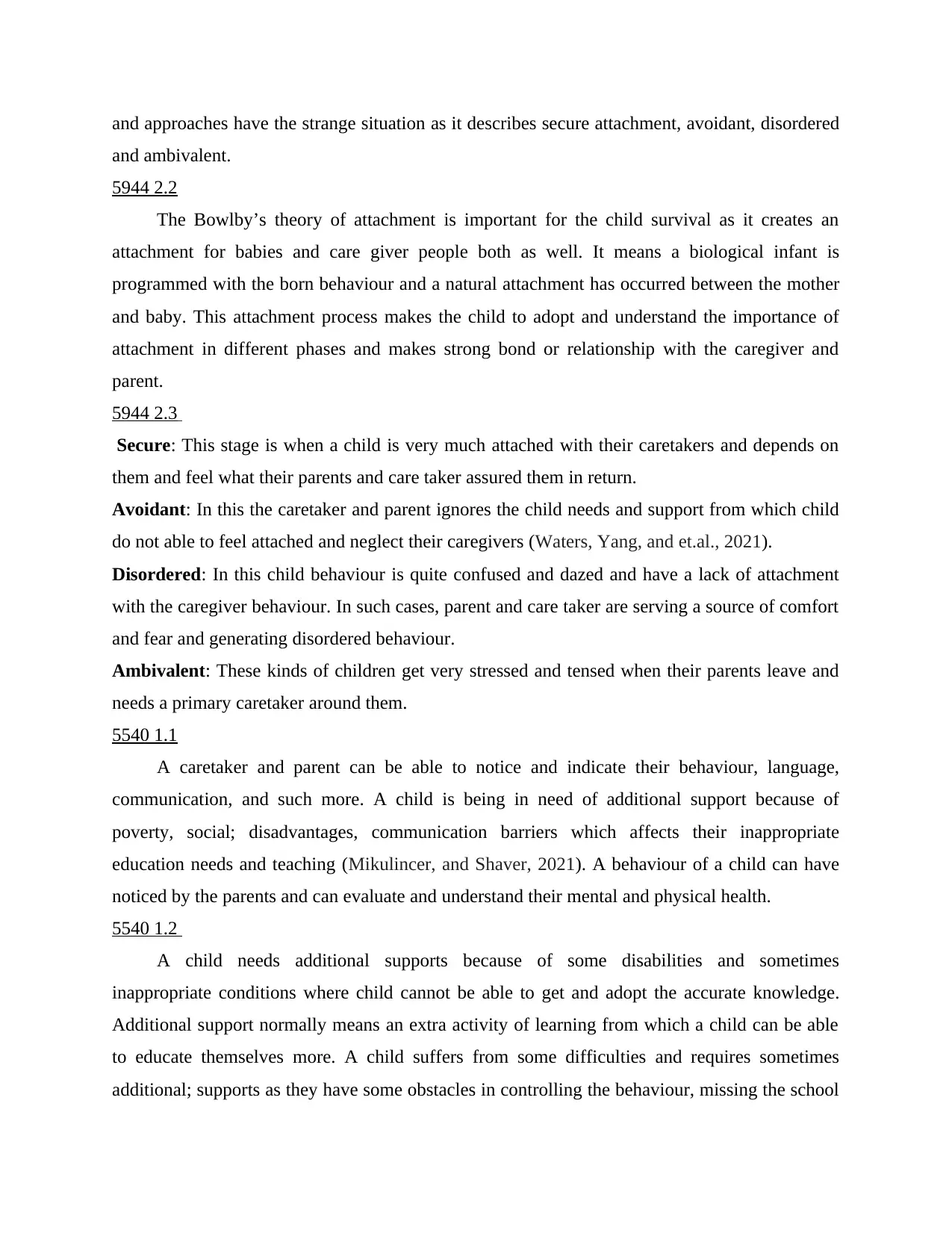
and approaches have the strange situation as it describes secure attachment, avoidant, disordered
and ambivalent.
5944 2.2
The Bowlby’s theory of attachment is important for the child survival as it creates an
attachment for babies and care giver people both as well. It means a biological infant is
programmed with the born behaviour and a natural attachment has occurred between the mother
and baby. This attachment process makes the child to adopt and understand the importance of
attachment in different phases and makes strong bond or relationship with the caregiver and
parent.
5944 2.3
Secure: This stage is when a child is very much attached with their caretakers and depends on
them and feel what their parents and care taker assured them in return.
Avoidant: In this the caretaker and parent ignores the child needs and support from which child
do not able to feel attached and neglect their caregivers (Waters, Yang, and et.al., 2021).
Disordered: In this child behaviour is quite confused and dazed and have a lack of attachment
with the caregiver behaviour. In such cases, parent and care taker are serving a source of comfort
and fear and generating disordered behaviour.
Ambivalent: These kinds of children get very stressed and tensed when their parents leave and
needs a primary caretaker around them.
5540 1.1
A caretaker and parent can be able to notice and indicate their behaviour, language,
communication, and such more. A child is being in need of additional support because of
poverty, social; disadvantages, communication barriers which affects their inappropriate
education needs and teaching (Mikulincer, and Shaver, 2021). A behaviour of a child can have
noticed by the parents and can evaluate and understand their mental and physical health.
5540 1.2
A child needs additional supports because of some disabilities and sometimes
inappropriate conditions where child cannot be able to get and adopt the accurate knowledge.
Additional support normally means an extra activity of learning from which a child can be able
to educate themselves more. A child suffers from some difficulties and requires sometimes
additional; supports as they have some obstacles in controlling the behaviour, missing the school
and ambivalent.
5944 2.2
The Bowlby’s theory of attachment is important for the child survival as it creates an
attachment for babies and care giver people both as well. It means a biological infant is
programmed with the born behaviour and a natural attachment has occurred between the mother
and baby. This attachment process makes the child to adopt and understand the importance of
attachment in different phases and makes strong bond or relationship with the caregiver and
parent.
5944 2.3
Secure: This stage is when a child is very much attached with their caretakers and depends on
them and feel what their parents and care taker assured them in return.
Avoidant: In this the caretaker and parent ignores the child needs and support from which child
do not able to feel attached and neglect their caregivers (Waters, Yang, and et.al., 2021).
Disordered: In this child behaviour is quite confused and dazed and have a lack of attachment
with the caregiver behaviour. In such cases, parent and care taker are serving a source of comfort
and fear and generating disordered behaviour.
Ambivalent: These kinds of children get very stressed and tensed when their parents leave and
needs a primary caretaker around them.
5540 1.1
A caretaker and parent can be able to notice and indicate their behaviour, language,
communication, and such more. A child is being in need of additional support because of
poverty, social; disadvantages, communication barriers which affects their inappropriate
education needs and teaching (Mikulincer, and Shaver, 2021). A behaviour of a child can have
noticed by the parents and can evaluate and understand their mental and physical health.
5540 1.2
A child needs additional supports because of some disabilities and sometimes
inappropriate conditions where child cannot be able to get and adopt the accurate knowledge.
Additional support normally means an extra activity of learning from which a child can be able
to educate themselves more. A child suffers from some difficulties and requires sometimes
additional; supports as they have some obstacles in controlling the behaviour, missing the school
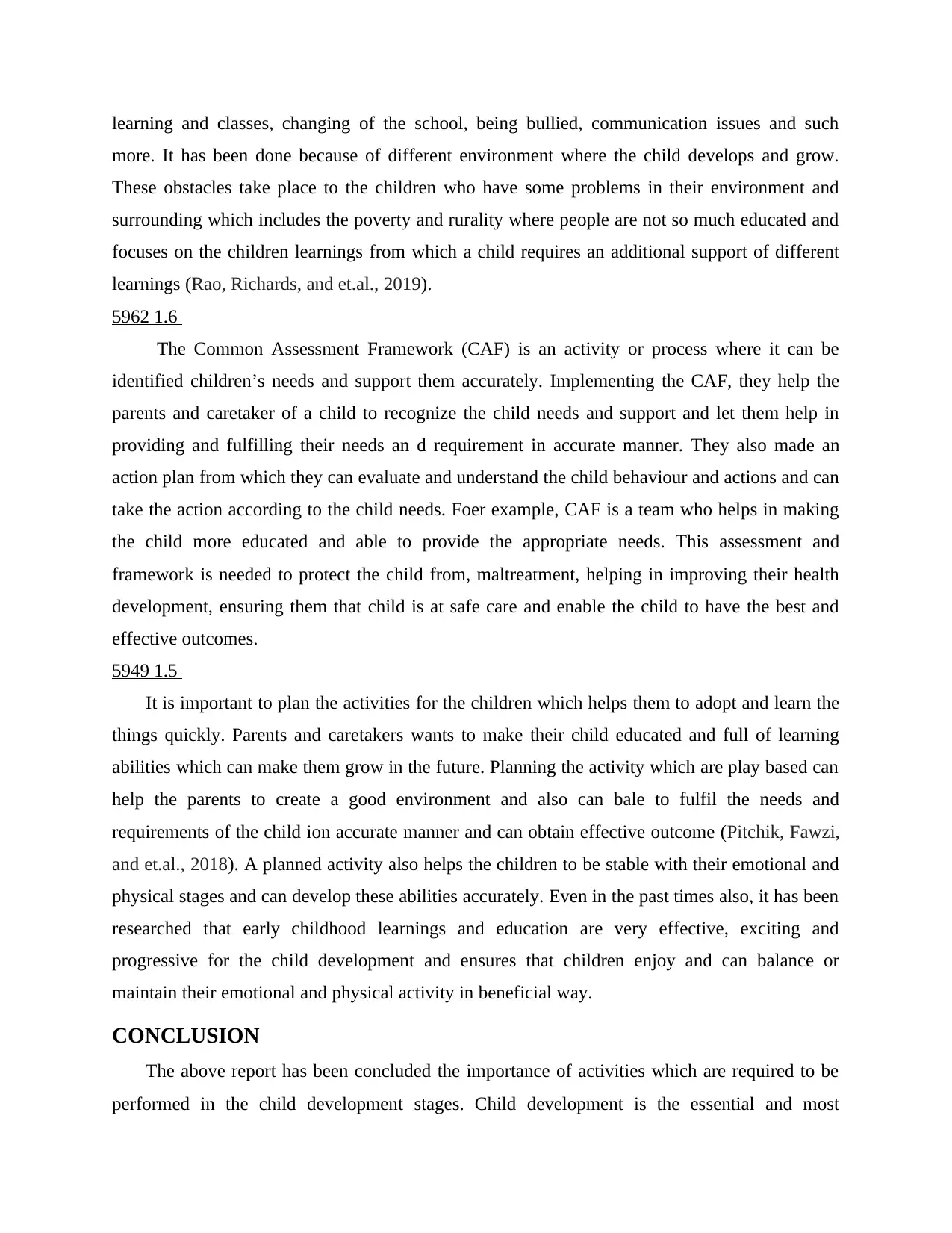
learning and classes, changing of the school, being bullied, communication issues and such
more. It has been done because of different environment where the child develops and grow.
These obstacles take place to the children who have some problems in their environment and
surrounding which includes the poverty and rurality where people are not so much educated and
focuses on the children learnings from which a child requires an additional support of different
learnings (Rao, Richards, and et.al., 2019).
5962 1.6
The Common Assessment Framework (CAF) is an activity or process where it can be
identified children’s needs and support them accurately. Implementing the CAF, they help the
parents and caretaker of a child to recognize the child needs and support and let them help in
providing and fulfilling their needs an d requirement in accurate manner. They also made an
action plan from which they can evaluate and understand the child behaviour and actions and can
take the action according to the child needs. Foer example, CAF is a team who helps in making
the child more educated and able to provide the appropriate needs. This assessment and
framework is needed to protect the child from, maltreatment, helping in improving their health
development, ensuring them that child is at safe care and enable the child to have the best and
effective outcomes.
5949 1.5
It is important to plan the activities for the children which helps them to adopt and learn the
things quickly. Parents and caretakers wants to make their child educated and full of learning
abilities which can make them grow in the future. Planning the activity which are play based can
help the parents to create a good environment and also can bale to fulfil the needs and
requirements of the child ion accurate manner and can obtain effective outcome (Pitchik, Fawzi,
and et.al., 2018). A planned activity also helps the children to be stable with their emotional and
physical stages and can develop these abilities accurately. Even in the past times also, it has been
researched that early childhood learnings and education are very effective, exciting and
progressive for the child development and ensures that children enjoy and can balance or
maintain their emotional and physical activity in beneficial way.
CONCLUSION
The above report has been concluded the importance of activities which are required to be
performed in the child development stages. Child development is the essential and most
more. It has been done because of different environment where the child develops and grow.
These obstacles take place to the children who have some problems in their environment and
surrounding which includes the poverty and rurality where people are not so much educated and
focuses on the children learnings from which a child requires an additional support of different
learnings (Rao, Richards, and et.al., 2019).
5962 1.6
The Common Assessment Framework (CAF) is an activity or process where it can be
identified children’s needs and support them accurately. Implementing the CAF, they help the
parents and caretaker of a child to recognize the child needs and support and let them help in
providing and fulfilling their needs an d requirement in accurate manner. They also made an
action plan from which they can evaluate and understand the child behaviour and actions and can
take the action according to the child needs. Foer example, CAF is a team who helps in making
the child more educated and able to provide the appropriate needs. This assessment and
framework is needed to protect the child from, maltreatment, helping in improving their health
development, ensuring them that child is at safe care and enable the child to have the best and
effective outcomes.
5949 1.5
It is important to plan the activities for the children which helps them to adopt and learn the
things quickly. Parents and caretakers wants to make their child educated and full of learning
abilities which can make them grow in the future. Planning the activity which are play based can
help the parents to create a good environment and also can bale to fulfil the needs and
requirements of the child ion accurate manner and can obtain effective outcome (Pitchik, Fawzi,
and et.al., 2018). A planned activity also helps the children to be stable with their emotional and
physical stages and can develop these abilities accurately. Even in the past times also, it has been
researched that early childhood learnings and education are very effective, exciting and
progressive for the child development and ensures that children enjoy and can balance or
maintain their emotional and physical activity in beneficial way.
CONCLUSION
The above report has been concluded the importance of activities which are required to be
performed in the child development stages. Child development is the essential and most
⊘ This is a preview!⊘
Do you want full access?
Subscribe today to unlock all pages.

Trusted by 1+ million students worldwide
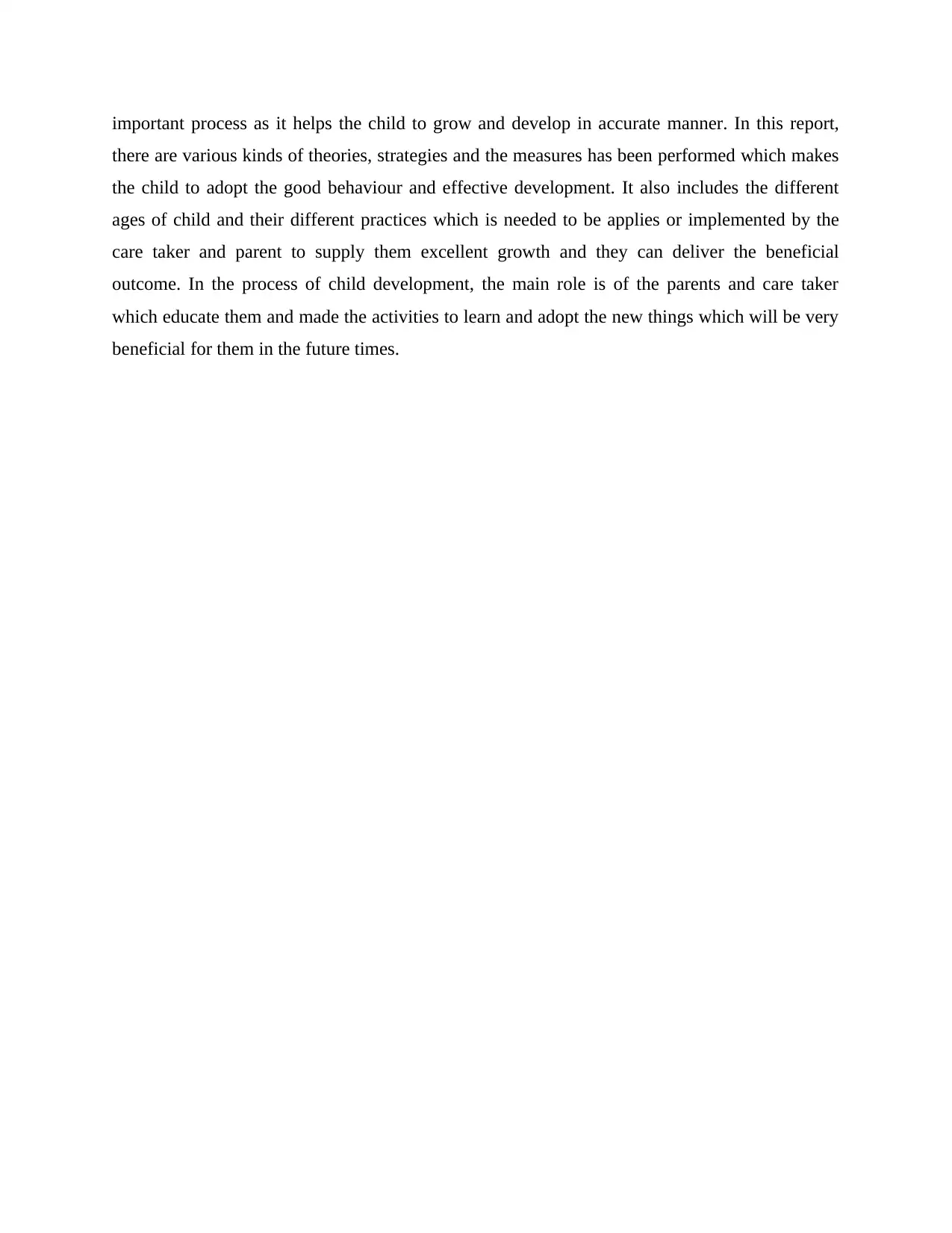
important process as it helps the child to grow and develop in accurate manner. In this report,
there are various kinds of theories, strategies and the measures has been performed which makes
the child to adopt the good behaviour and effective development. It also includes the different
ages of child and their different practices which is needed to be applies or implemented by the
care taker and parent to supply them excellent growth and they can deliver the beneficial
outcome. In the process of child development, the main role is of the parents and care taker
which educate them and made the activities to learn and adopt the new things which will be very
beneficial for them in the future times.
there are various kinds of theories, strategies and the measures has been performed which makes
the child to adopt the good behaviour and effective development. It also includes the different
ages of child and their different practices which is needed to be applies or implemented by the
care taker and parent to supply them excellent growth and they can deliver the beneficial
outcome. In the process of child development, the main role is of the parents and care taker
which educate them and made the activities to learn and adopt the new things which will be very
beneficial for them in the future times.
Paraphrase This Document
Need a fresh take? Get an instant paraphrase of this document with our AI Paraphraser
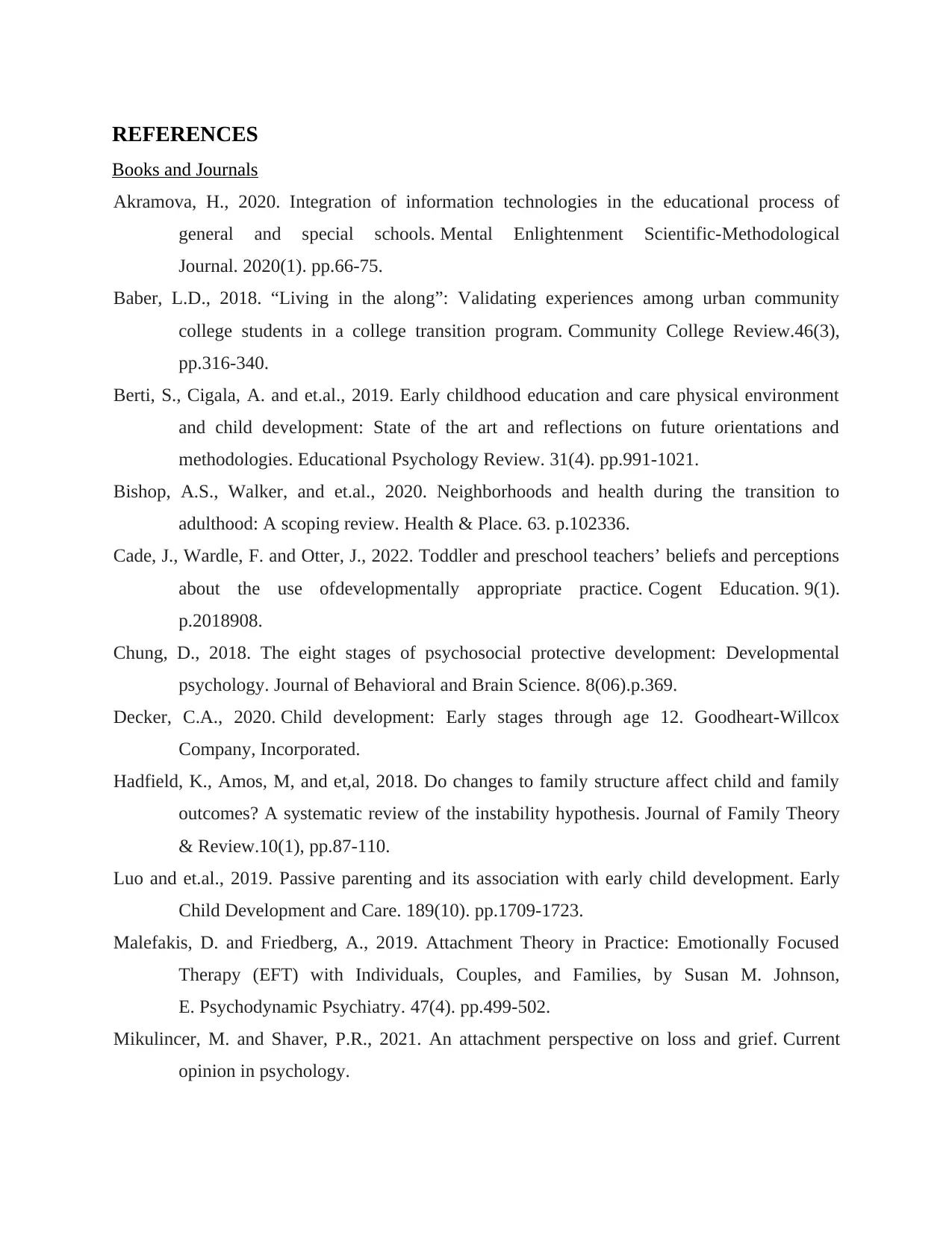
REFERENCES
Books and Journals
Akramova, H., 2020. Integration of information technologies in the educational process of
general and special schools. Mental Enlightenment Scientific-Methodological
Journal. 2020(1). pp.66-75.
Baber, L.D., 2018. “Living in the along”: Validating experiences among urban community
college students in a college transition program. Community College Review.46(3),
pp.316-340.
Berti, S., Cigala, A. and et.al., 2019. Early childhood education and care physical environment
and child development: State of the art and reflections on future orientations and
methodologies. Educational Psychology Review. 31(4). pp.991-1021.
Bishop, A.S., Walker, and et.al., 2020. Neighborhoods and health during the transition to
adulthood: A scoping review. Health & Place. 63. p.102336.
Cade, J., Wardle, F. and Otter, J., 2022. Toddler and preschool teachers’ beliefs and perceptions
about the use ofdevelopmentally appropriate practice. Cogent Education. 9(1).
p.2018908.
Chung, D., 2018. The eight stages of psychosocial protective development: Developmental
psychology. Journal of Behavioral and Brain Science. 8(06).p.369.
Decker, C.A., 2020. Child development: Early stages through age 12. Goodheart-Willcox
Company, Incorporated.
Hadfield, K., Amos, M, and et,al, 2018. Do changes to family structure affect child and family
outcomes? A systematic review of the instability hypothesis. Journal of Family Theory
& Review.10(1), pp.87-110.
Luo and et.al., 2019. Passive parenting and its association with early child development. Early
Child Development and Care. 189(10). pp.1709-1723.
Malefakis, D. and Friedberg, A., 2019. Attachment Theory in Practice: Emotionally Focused
Therapy (EFT) with Individuals, Couples, and Families, by Susan M. Johnson,
E. Psychodynamic Psychiatry. 47(4). pp.499-502.
Mikulincer, M. and Shaver, P.R., 2021. An attachment perspective on loss and grief. Current
opinion in psychology.
Books and Journals
Akramova, H., 2020. Integration of information technologies in the educational process of
general and special schools. Mental Enlightenment Scientific-Methodological
Journal. 2020(1). pp.66-75.
Baber, L.D., 2018. “Living in the along”: Validating experiences among urban community
college students in a college transition program. Community College Review.46(3),
pp.316-340.
Berti, S., Cigala, A. and et.al., 2019. Early childhood education and care physical environment
and child development: State of the art and reflections on future orientations and
methodologies. Educational Psychology Review. 31(4). pp.991-1021.
Bishop, A.S., Walker, and et.al., 2020. Neighborhoods and health during the transition to
adulthood: A scoping review. Health & Place. 63. p.102336.
Cade, J., Wardle, F. and Otter, J., 2022. Toddler and preschool teachers’ beliefs and perceptions
about the use ofdevelopmentally appropriate practice. Cogent Education. 9(1).
p.2018908.
Chung, D., 2018. The eight stages of psychosocial protective development: Developmental
psychology. Journal of Behavioral and Brain Science. 8(06).p.369.
Decker, C.A., 2020. Child development: Early stages through age 12. Goodheart-Willcox
Company, Incorporated.
Hadfield, K., Amos, M, and et,al, 2018. Do changes to family structure affect child and family
outcomes? A systematic review of the instability hypothesis. Journal of Family Theory
& Review.10(1), pp.87-110.
Luo and et.al., 2019. Passive parenting and its association with early child development. Early
Child Development and Care. 189(10). pp.1709-1723.
Malefakis, D. and Friedberg, A., 2019. Attachment Theory in Practice: Emotionally Focused
Therapy (EFT) with Individuals, Couples, and Families, by Susan M. Johnson,
E. Psychodynamic Psychiatry. 47(4). pp.499-502.
Mikulincer, M. and Shaver, P.R., 2021. An attachment perspective on loss and grief. Current
opinion in psychology.

Orenstein, G.A. and Lewis, L., 2020. Eriksons stages of psychosocial development. StatPearls
[Internet].
Pitchik, H.O., Fawzi, and et.al., 2018. Prenatal nutrition, stimulation, and exposure to
punishment are associated with early child motor, cognitive, language, and
socioemotional development in Dar es Salaam, Tanzania. Child: care, health and
development. 44(6). pp.841-849.
Pooch, A., Natale, R. and Hidalgo, T., 2019. Ages and stages questionnaire: Social–Emotional as
a Teacher-Report measure. Journal of Early Intervention. 41(1). pp.3-12.
Rao, N., Richards, and et.al., 2019. Early childhood education and child development in four
countries in East Asia and the Pacific. Early Childhood Research Quarterly. 47, pp.169-
181.
Waters, T.E., Yang, R, and et.al., 2021. An empirical test of prototype and revisionist models of
attachment stability and change from middle childhood to adolescence: A 6‐year
longitudinal study. Child development.
[Internet].
Pitchik, H.O., Fawzi, and et.al., 2018. Prenatal nutrition, stimulation, and exposure to
punishment are associated with early child motor, cognitive, language, and
socioemotional development in Dar es Salaam, Tanzania. Child: care, health and
development. 44(6). pp.841-849.
Pooch, A., Natale, R. and Hidalgo, T., 2019. Ages and stages questionnaire: Social–Emotional as
a Teacher-Report measure. Journal of Early Intervention. 41(1). pp.3-12.
Rao, N., Richards, and et.al., 2019. Early childhood education and child development in four
countries in East Asia and the Pacific. Early Childhood Research Quarterly. 47, pp.169-
181.
Waters, T.E., Yang, R, and et.al., 2021. An empirical test of prototype and revisionist models of
attachment stability and change from middle childhood to adolescence: A 6‐year
longitudinal study. Child development.
⊘ This is a preview!⊘
Do you want full access?
Subscribe today to unlock all pages.

Trusted by 1+ million students worldwide
1 out of 12
Related Documents
Your All-in-One AI-Powered Toolkit for Academic Success.
+13062052269
info@desklib.com
Available 24*7 on WhatsApp / Email
![[object Object]](/_next/static/media/star-bottom.7253800d.svg)
Unlock your academic potential
Copyright © 2020–2025 A2Z Services. All Rights Reserved. Developed and managed by ZUCOL.




